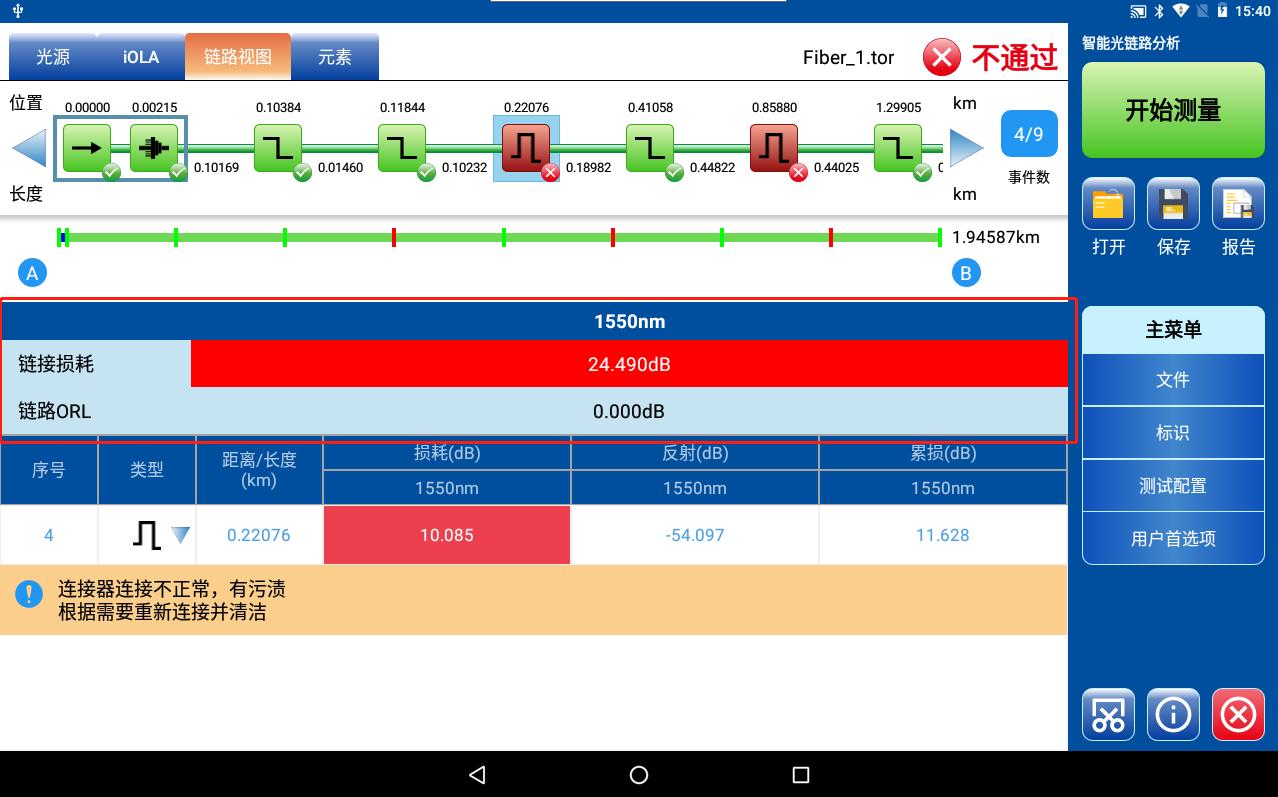OTDR Intelligent Optical Link Analysis (IOLA) Function - A Must-Have for Fiber Test Engineers
Against the backdrop of 5G and large-scale construction of fiber networks, the intelligent upgrade of optical time domain reflectometers (OTDRs) has become an industry necessity. TFN RM7 optical time domain reflectometer, with intelligent optical link analysis function as its core, provides efficient and accurate solutions for fiber testing and is becoming a standard tool for engineers.
1. Intelligent Optical Link Analysis: A Leap from "Manual Image Interpretation" to "Intelligent Diagnosis"
Traditional OTDRs rely on manual analysis of curves, which is inefficient and prone to errors. TFN RM7's Intelligent Optical Link Mapper (OTDR IOLM) function achieves three major breakthroughs through AI algorithms:
Fully automatic event recognition: It can automatically mark 20+ types of events such as splices and connectors, with a positioning accuracy of 0.05 meters and an error control of ±(0.8+0.005%* distance). In a 200-kilometer trunk line test, RM7 completed the full link analysis in just 5 minutes, accurately identifying 0.01dB-level losses.
Visual topology presentation: The 10.1-inch multi-touch screen supports 3D dynamic zooming, converting complex links into a graphical interface. Engineers can quickly switch between event lists and curve views through gestures.
Intelligent report generation: After the test, a PDF report containing total loss, event distribution, and rectification suggestions is automatically output, saving 70% of data sorting time.

2. Three core application scenarios: the practical value of full network coverage
Ultra-long-distance backbone network maintenance
RM7 OTDR fiber optic tester has a 50dB ultra-large dynamic range and can complete 330 km optical cable testing in a single time to avoid segment splicing errors. In the inter-provincial trunk line project, its automatic gain adjustment technology makes the 0.001dB loss jump of the 240 km link clearly presented.
Precise operation and maintenance of FTTx/PON networks
For fiber-to-the-home (FTTH) scenarios, the 0.6-meter event blind area and the 1-meter attenuation blind area can accurately locate splitter loss and ONT failures. The operator used RM7 to complete the acceptance of 500 FTTH links within 1 hour, locate 23 connection anomalies, and increase efficiency by 3 times.
Emergency repair and fault location
In real-time test mode, TFN RM7 OTDR can locate the fault point within 10 seconds with an error of less than 8 meters. During the typhoon repair, the communication team relied on its laser ranging (0.03-40 meters, ±0.02 meter accuracy) and optical link analysis functions to lock the deep buried breakpoint within 15 minutes, which is 50% faster than the traditional solution.
3. Technological innovation: Reconstructing the efficiency and cost benchmark of optical fiber testing
RM7 OTDR machine solves industry pain points through technological innovation:
Rich and efficient operation: You can use a variety of tools to perform complete OTDR tests and control all test parameters; all parameters can be set in one interface, which is convenient for engineers to operate.
Extreme environmental adaptability: -10℃~50℃ operating temperature range and protection design ensure stable field operations. In an oil field project, the equipment worked continuously for 12 hours in a -25℃ environment, and the data repeatability error was <0.02dB.
Cost optimization design: Modules such as optical power meter and VFL visual fault location support plug-in and independent use, and "one machine for multiple uses" reduces equipment procurement costs by 30%. Compared with imported brands, the price of RM7 is only 2/3, and it provides a two-year warranty.
4. Industry Trends: Intelligence drives OTDR into the 4.0 era
With the advancement of new infrastructure, the complexity of optical fiber networks has increased sharply, and traditional OTDRs can no longer meet the needs. TFN RM7, with its characteristics of "high dynamics (50dB), low blind area (0.6 meters), and full-function integration", promotes OTDR from the "tool era" to the "intelligent era". Its value lies not only in the breakthrough of technical parameters, but also in the release of manpower through AI, allowing engineers to focus on decision-making rather than operation-this is the core competitiveness of future optical fiber operation and maintenance.
In the wave of digitalization, RM7 breaks the monopoly with "top performance + cost-effectiveness" and redefines the OTDR standard. For engineers, choosing RM7 is not only choosing a tool, but also choosing an efficient and reliable operation and maintenance method to lay a solid foundation for the stable operation of the communication network.
